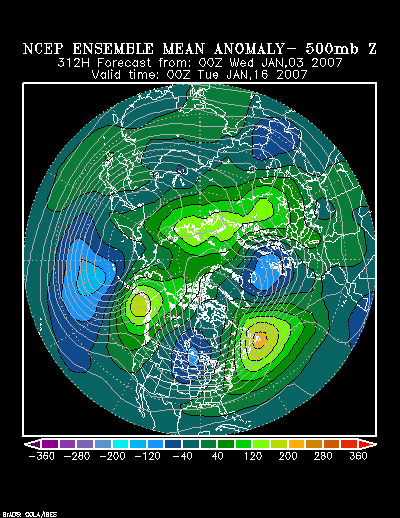In multiple places in this thread, it has been noted that the demise of super long-duration AO+ regimes has often been followed by periods of frequent blocking. As the current 39-day event approaches its flip to negative in the January 10-20 timeframe, the NCEP ensemble mean 500 mb anomalies are showing that such blockiness is likely to occur consistent with historic experience.
If one examines the animation of hours 312 through 360, one finds:
1. A dramatic collapse of the below to much-below normal height anomalies as they head into Europe.
2. The increase in above normal height anomalies across the North Atlantic
3. The possible departure of an area of above to much-above normal height anomalies from the vicinity of Newfoundland possibly toward the vicinity of Greenland or Europe.

That third point is particularly intriguing. It bears watching, as it may pave the road for a longer, stronger episode of blocking. On 12/29 I described how such an evolution has occurred in two notable occasions. Those excerpts follow:
Here’s how such a situation has evolved in the past:
• An area of above to much above normal height of anomalies has moved off North America in the vicinity of Newfoundland (sometimes slowly, but sometimes more quickly).
• 2-4 days later that area was centered south of Iceland.
• 2-4 days later that area grew elongated (sometimes stretching from Europe to or across much of North America i.e., January 1958 and February 1962)
• From that it either continued to head for Europe where it often transitioned into a Scandanavian block that then retrograded or took a “short-cut” toward Iceland and from there retrograded.
During this evolution of events, one saw the area of above normal height anomalies periodically go through pulses of amplification and de-amplification. Later, the block remained in a semi-permanent position. In 1958, that block was largely centered in the vicinity of the Davis Strait from where it drifted, sometimes to the Hudson Bay area. In 1962, the block reached Scandanavia then very slowly retrograded across Greenland to the Davis Strait. That process consumed 6 days after the a 12-day “elongated” phase. Afterward, it took up a semi-permanent residence in the vicinity of the Davis Strait, while drifting somewhat as happened in 1958.
In terms of sensible weather, my position from that post unchanged:
one should not assume that it will translate into an Arctic blast for the East. It will probably come east and reach the East Coast near January 15 +/- 2 days and bring a shot of meaningful cold. Nonetheless, if historic experience holds up, its lowest temperatures probably won’t fall below 15° in either New York City or Philadelphia. The following snippet from earlier in this thread sums up this situation reasonably well:
...readings will merely trend to normal with occasional periods of somewhat below normal cold following the fall of the AO+ regime. More significant cold in which one or more days could see readings fall below 15° in New York City and Philadelphia might not reach the East for 10-14 days after the AO flips to negative.
Having said this, a temperature regime that is closer to normal will begin to be established in the East. There remains a chance at one additional blowtorch effort before February. However, if such a situation arises, it will likely be brief. As the month advances, the synoptic framework for more sustained and significant cold will continue to evolve.
All said, the timing of the AO's turn to negative and pattern change remain on track. Consistent with historic experience following the demise of super long-duration AO+ regimes, the ensemble guidance is now showing a better environment for more frequent blocking.
 The posts in this forum are NOT official forecast and should not be used as such. They are just the opinion of the poster and may or may not be backed by sound meteorological data. They are NOT endorsed by any professional institution or
The posts in this forum are NOT official forecast and should not be used as such. They are just the opinion of the poster and may or may not be backed by sound meteorological data. They are NOT endorsed by any professional institution or 





